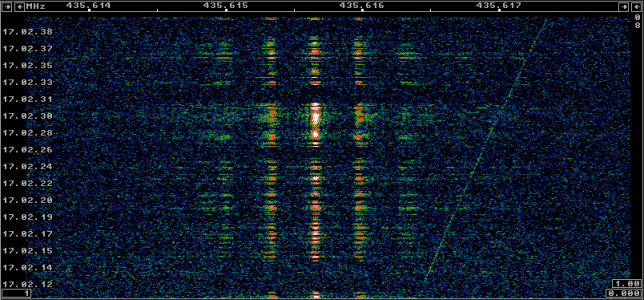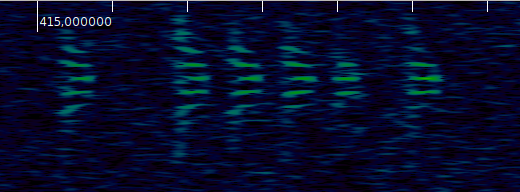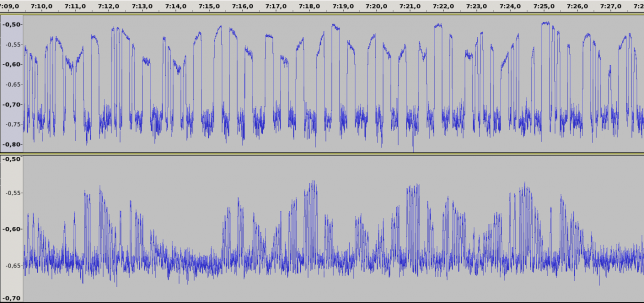Last Thursday, a CZ-11 Chinese rocket launched from Jiuquan. Alan Kung BA1DU posted in amsat-bb some minutes after launch saying that this launch contains an Amateur payload: CAS-2T. As it is usual with Chinese Amateur satellites, little information is available publicly and we hadn’t heard about CAS-2T before.
According to BA1DU, CAS-2T is a 2U Cubesat with a CW beacon on 70cm and a V/U FM transponder. The satellite will not separate from the upper stage of the rocket, so it will decay between 10 and 30 days before launch. However, this is not correct. After launch, CAS-2T was identified as object 2016-066E by Mike Rupprecht DK3WN using Doppler measurements. This object is on a 1030km x 500km elliptical orbit, so it will not decay soon. Apparently, due to a problem in the launch, the upper stage of the rocket has being put in this 10 year+ orbit. Indeed, there are radar TLEs for 6 objects from this launch. Four of them are on circular orbits of roughly 500km height, while the other two are on elliptical orbits of 1030km x 500km radius. All of these orbits will last for many years.
Reports of CAS-2T from Amateurs worldwide agree that the CW signal has good strength, but it suffers much fading. Unfortunately, the FM transponder does not function properly. It seems to respond well to an uplink signal, but it doesn’t modulate properly, as if it lacked power or suffered some other problem. On Friday afternoon, I took an SDR recording of the CW and FM signals of CAS-2T during its orbit 25. Here I show some measurements of these signals. The recording was done with a 7 element yagi and a FUNcube Dongle Pro+, and it has been Doppler corrected using the TLE for object 2016-066E, which gives a very good match.
This is what the FM downlink signal from CAS-2T looks like on the waterfall. The software used is linrad. The signal is choppy and it presents sidebands which are roughly 320Hz apart.

The CW signal is strong, up to 22dB SNR in 500Hz bandwidth. Below you can see the signal strength plot in linrad during the strongest moments of the pass. The slant range at closest approach was around 1300km.

At the moments when the FM signal is strongest, its strength is more or less the same as the strength of the CW signal. However, FM has to be copied in a much larger bandwidth than CW, and it needs more SNR. This means that the FM signal is relatively weak.
In the image below you can see a detail of the choppy FM signal. The software used is inspectrum. The horizontal tick marks are 100ms apart. The periods when the transmitter is on are around 55ms long and the off gaps are 25ms long. Thus, the FM transmitter oscillates at a frequency of roughly 12Hz.

Below you can see the power of the CW and FM signals. To obtain this plot, both signals have being filtered to bandwidths of 500Hz and 4000Hz respectively with GNU Radio. Then, the power of each signal has being calculated and averaged over a window of 10ms. Finally, the average power is converted to dB units and written to a file of floats. This file is imported in Audacity and attenuated 40dB to make the values fit between -1 and 1. This means that the units of the vertical axis are in 100dB’s.

Here we can see the fast fading both on the CW and FM signals. The period of the fading oscillates between 1.5 seconds and 3 seconds throughout the pass. This suggests that the satellite (together with the upper stage of the rocket) is spinning quite fast. The fading frequency for CW and FM signals is roughly the same, but the phases of the fading do not coincide (meaning that the nulls do not happen at the same time on both signals). These suggests that a different antenna is used for each signal. AMSAT-UK has a picture of CAS-2T which shows 3 antennas. Probably two of them are used for each of the downlink signals and the third one is for the uplink.
One can also see the choppiness of the FM signal in this plot. It is possible to measure the period of the chops using Audacity. It is consistently 80ms throughout the pass, in agreement with the measurements we have done above in inspectrum. The FM signal peaks to about -55dB in this image, while the CW image peaks at nearly -50dB. We can say that the FM signal is between 3dB and 5dB weaker than the CW signal. It doesn’t make any sense to build a satellite with this relation of powers between its FM and CW signals. The FM signal should be much stronger. Thus, we suspect that the FM signal is not developing its full design power.
Thanks for sharing this, and great explanation.
73 Jan PE0SAT
Thanks Dani
good job
thanks for the info
I agree, the FM transponder does not seem to modulate properly. I would be very surprised if anyone was able to make a two-way QSO using it. If they do, hopefully they will record and provide some good evidence (preferably SDR IQ recordings.)